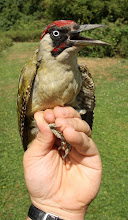Tuesday, 20 April 2010
23:30 on 20/04/10
A very vocal hedgehog brought me to my window just now (I didn't see it despite shining a torch). I looked up into the night sky and saw some flashing lights from an aircraft. This is good news - I'm booked on a flight to Menorca on Friday!
Oystercatcher with ring
A brief evening visit to Castle Mill (20/04/10) revealed a ring on one of the two resident Oystercatchers! See the previous post for a photograph of these birds. This bird was most likely ringed locally several years ago.
The species can be quite long lived - the British longevity record for a ringed Oystercatcher is 36 years and 8 months held by the Wash Wader Ringing Group. They believe that this record could easily be extended.
The species can be quite long lived - the British longevity record for a ringed Oystercatcher is 36 years and 8 months held by the Wash Wader Ringing Group. They believe that this record could easily be extended.
Sunday, 18 April 2010
Castle Mill birds 18/04/10
I made a dawn walk to Castle Mill gravel pit today to see the birds and try my new scope & camera.
The results of my digiscoping are here ... well, the best bits anyway! Not super brilliant - the birds were still too far away & I've still got to get the hang of it all.

Above: A regular pair of Oystercatcher. Last year they tried to nest but rising water levels eventually covered their nesting site. This year the water levels have started high but at the moment they are dropping. Looking good to attract more waders ... (5 Temmincks Stints were last years highlight).

Above: Two Little Ringed Plover. I saw a third but the results of the photographs weren't as good. 3 were present on Friday also.

Above: The water remained almost perfectly still early on and this Great Crested Grebe strayed into my sights - exhibitionist that it was!

Above: After the early morning photography, I settled down to have a better look around. A species that I haven't seen at this site before (not that I've been looking hard and when I have, I only had a pair of binoculars!). This is a Common Snipe. Not being familiar with viewing this species in the field (or at all!) I had to check that it was a Common Snipe.

Above: Having confirmed my identification of Common Snipe, I was surprised to be viewing a Yellow Wagtail (a migrant species that has started arriving in the last week or so) at the same time. As I spent more time looking at what else was around and being more confident with the identification, I found 5 Snipe in total.

Above: A species that can always be seen here, Redshank. Although difficult to count just how many there are here, I have seen 6 flying together recently and this is around what I would expect. Also present was a Green Sandpiper (4 on Friday).
25-30 Sand Martins
1 Swallow
Female Mallard with 10 ducklings (present since Friday)
1 Grey Wagtail
2 Pied Wagtail (I did well with the wagtail species!)
The usual Great Crested Grebes, Coots, moorhen, Mallards, Cormorants, 3 herons, tufted ducks and 2 swans.
Now that I have a scope, I might make this a more regular walk.

Above: Plenty of them about but never a family of birds that I want much to do with ... gulls. I'll leave it at that.
The results of my digiscoping are here ... well, the best bits anyway! Not super brilliant - the birds were still too far away & I've still got to get the hang of it all.

Above: A regular pair of Oystercatcher. Last year they tried to nest but rising water levels eventually covered their nesting site. This year the water levels have started high but at the moment they are dropping. Looking good to attract more waders ... (5 Temmincks Stints were last years highlight).

Above: Two Little Ringed Plover. I saw a third but the results of the photographs weren't as good. 3 were present on Friday also.

Above: The water remained almost perfectly still early on and this Great Crested Grebe strayed into my sights - exhibitionist that it was!

Above: After the early morning photography, I settled down to have a better look around. A species that I haven't seen at this site before (not that I've been looking hard and when I have, I only had a pair of binoculars!). This is a Common Snipe. Not being familiar with viewing this species in the field (or at all!) I had to check that it was a Common Snipe.

Above: Having confirmed my identification of Common Snipe, I was surprised to be viewing a Yellow Wagtail (a migrant species that has started arriving in the last week or so) at the same time. As I spent more time looking at what else was around and being more confident with the identification, I found 5 Snipe in total.

Above: A species that can always be seen here, Redshank. Although difficult to count just how many there are here, I have seen 6 flying together recently and this is around what I would expect. Also present was a Green Sandpiper (4 on Friday).
25-30 Sand Martins
1 Swallow
Female Mallard with 10 ducklings (present since Friday)
1 Grey Wagtail
2 Pied Wagtail (I did well with the wagtail species!)
The usual Great Crested Grebes, Coots, moorhen, Mallards, Cormorants, 3 herons, tufted ducks and 2 swans.
Now that I have a scope, I might make this a more regular walk.

Above: Plenty of them about but never a family of birds that I want much to do with ... gulls. I'll leave it at that.
Subscribe to:
Comments (Atom)



